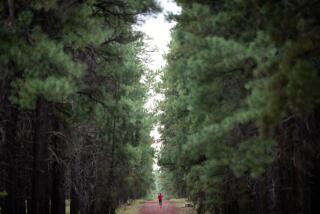Experiencing the High Life
- Share via
Older people, so the stereotype goes, are just asking for health problems when they travel to higher altitudes.
Not necessarily, say researchers who have studied the effects of altitude on older travelers and published their studies recently in three medical journals.
The bottom line for 65-plus travelers in reasonably good health who want to visit mountain communities at moderate altitudes of 8,500 to 9,000 feet: “Be careful but don’t be afraid,” said Dr. Charles S. Houston, professor emeritus of medicine at the University of Vermont and a respected researcher in the field.
Among the findings by Houston and others:
* Older travelers actually had a slightly lower incidence of acute mountain sickness (or altitude sickness) than younger people, according to a study by Houston and others published in January in the Western Journal of Medicine.
Houston’s team evaluated 97 travelers, ages 59 to 83, who had gone to Vail, Colo. (elevation 8,200 feet), for the 50th reunion of the U.S. Army 10th Mountain Division. Sixteen percent experienced mountain sickness, a slightly lower percent than generally reported for younger people. The study did not explore the reasons for this.
Mountain sickness occurs because of the reduced atmospheric pressure (and thus reduced oxygen) at higher altitudes. Symptoms can include dizziness, headaches and nausea, and, if the condition progresses, it can be life-threatening.
“It is generally safe for older men and women, including those with underlying asymptomatic heart and lung disease, to make short visits to moderate altitudes,” the researchers concluded.
* In another report on the same Vail travelers, researchers concluded that ascent to a moderate altitude did not seem to bring on myocardial ischemia (decreased blood supply to the heart) in people with asymptomatic coronary artery disease. Over a four-day period, the researchers measured blood pressures and took resting electrocardiograms daily. Their study was published recently in Wilderness and Environmental Medicine.
* Older travelers were also found less likely than younger travelers to be stricken with acute mountain sickness in another study of 3,158 travelers, ages 16 to 87, who were visiting resort communities in the Rocky Mountains with elevations ranging from 6,300 to 9,700 feet. Overall, acute mountain sickness occurred in 25% of visitors to moderate altitude, Houston and his colleagues wrote in 1993 in the Annals of Internal Medicine, but was more likely in those under age 60.
Overall, they also found mountain sickness more likely to strike those travelers who usually live at sea level and who have a history of mountain sickness or underlying lung problems. The researchers found those less physically fit more prone to mountain sickness, although other investigators have found the opposite.
Altitude sickness is most likely to strike at about 8,000 feet, said Dr. Richard Nicholas, an assistant professor in the department of medicine at the University of Colorado and another researcher in the Vail study. “But it can occur as low as 5,000 feet.”
Older travelers are advised to consult their physician before traveling to higher altitudes. But Houston offers a general guideline: “People with heart or lung disease who get along well at sea level aren’t any worse off at altitude.”
Once at higher altitudes, he tells older travelers to drink plenty of water. “Don’t exercise intensely the first day. Take things easier.”
Several prescription drugs can be used, if necessary, to lessen the symptoms of altitude sickness. Travelers should consult their physicians for advice if they feel drugs might be helpful.
*
Although U.S. supplies of Transderm Scop, the patch worn behind the ear to prevent motion sickness, are all but exhausted (The Healthy Traveler, March 26) the medication might still be available overseas.
One Times reader reported he recently bought a patch over-the-counter (without a prescription) in Australia.
“The patch has been available previously on an over-the-counter basis in Australia, Holland and South Africa,” said Mark Ryan, spokesman for CIBA Consumer Pharmaceuticals of Woodbridge, N.J., the sole U.S. manufacturer of the patch. But the current status of such supplies is impossible to gauge, he said.
CIBA halted manufacture of the patch last August because of a production problem, Ryan said, but the company is hopeful that supplies will be available again late this year. (For updates, call the CIBA hot line, 800-452-0051.)
Meanwhile, some pharmacists are filling patch prescriptions by providing customers with scopolamine mixed in a gel, which is then squeezed from a pre-measured applicator onto the inside of the wrist and rubbed in. The dose is repeated every eight to 12 hours. In the last three months, Robert Root, a pharmacist at B&B; Pharmacy in Bellflower, said he has filled perhaps 20 or 25 such prescriptions.
Operating as a “compounding pharmacy,” B&B; takes a doctor’s prescription and makes up the prescription from raw materials, Root said. There are 10 to 15 such pharmacies in the Los Angeles area, Root said. A community pharmacy, on the other hand, fills prescriptions with already-made medicines from the manufacturer. (A group called Professionals & Patients for Customized Care, a Houston-based organization of compounding pharmacists, can provide names of compounding pharmacists in specific areas 713-933-8400.)
“Compounding is a special niche (in pharmacy),” said Carlo Michelotti, senior vice president of professional affairs for the California Pharmacists Assn. “There are pharmacists who can do this--but they have to be specially trained and have the appropriate gel to deliver the drug accurately.”
A spokesman for the Food and Drug Administration said such compounding is acceptable since the chemical scopolamine is approved by the FDA.
The Healthy Traveler appears the second and fourth week of every month.






